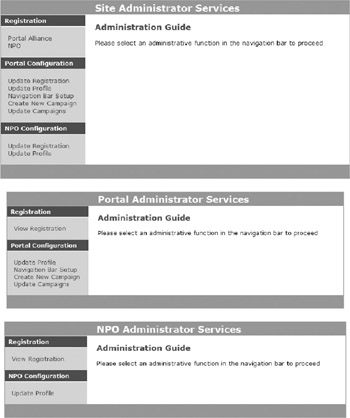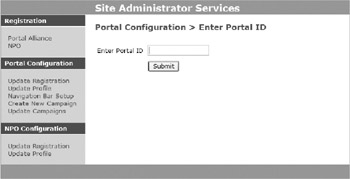Organizing Content
Site content must be organized from the perspective of its users; therefore, an information architect must think like a critical consumer. A user accessing a site is analogous to a shopper at a department store. A well-designed department store will clearly direct the shoppers to the appropriate aisle. The labeling used in identifying various sections of the store lets the shopper know what to expect when he or she gets there. For example, the Children's Apparel section will not be labeled as Children's Accessories because the word "accessories" is ambiguous in this context. A few visits to the store makes a shopper adapt to its organization, labeling, and navigation scheme, and he or she is able to find items more quickly.
There are several techniques for organizing a site's content. Some of these techniques are explained in the context of the sample application as follows:
-
Alphabetical An example of alphabetical organization is a directory service that lists the entries by name. In the sample application, the non-profits resulting from a search query are ordered alphabetically.
-
Topical An example of topical organization is an educational site that lists the content by subjects. Most sites use topical organization in conjunction with other organization schemes. In the sample application, the grouping of administrator services resembles a topical organization scheme, segregated from the grouping of donor services. In the following illustration, the services are arranged under Registration, Portal Configuration, and NPO Configuration.

-
Geographical Examples of geographical organization are observed on sites dealing with weather forecasts, distribution centers, and store locators. Content on such sites is location specific. In the sample application, the featured non-profits are organized by the region code.
-
Hierarchical An example of hierarchical organization is a corporate site that is structured according to divisions and departments. Hierarchical information is easily understood and therefore easier to navigate. This organization scheme is encountered very frequently in our day-to-day lives. Several simple hierarchies are present in the sample application.
-
Indexed Indexed organization schemes are powerful for dynamic content. The content is usually indexed in a relational database, and the indexing mechanism drives content selection. Templating mechanisms may use this organization scheme for serving dynamic content. In the sample application, the campaigns are indexed by portal-domain and the region code. Even though the campaigns are changing on a frequent basis, the indexing mechanism reorganizes the content and helps in the retrieval of only those campaigns that are relevant for a given portal-domain and region combination.
-
Role-oriented For a given role, content can be organized statically according to a predetermined taxonomy or created dynamically on role detection. A role-oriented content organization scheme can be coupled with a goal- or task-oriented content organization scheme. In the sample application, each type of administrator is provided with an administrative page with a navigation bar based on the administrator's type; furthermore, the page sequence for a site administrator is different from the page sequence for a portal or an NPO administrator. The following illustration shows the navigation bar that is customized for different administrators.

The following page only appears in the navigation scheme of a site administrator; this is because the site administrator has to identify the Portal ID for which he or she desires to act as a stand-in for the portal administrator.

EAN: 2147483647
Pages: 111
- ERP System Acquisition: A Process Model and Results From an Austrian Survey
- Distributed Data Warehouse for Geo-spatial Services
- A Hybrid Clustering Technique to Improve Patient Data Quality
- Relevance and Micro-Relevance for the Professional as Determinants of IT-Diffusion and IT-Use in Healthcare
- Development of Interactive Web Sites to Enhance Police/Community Relations